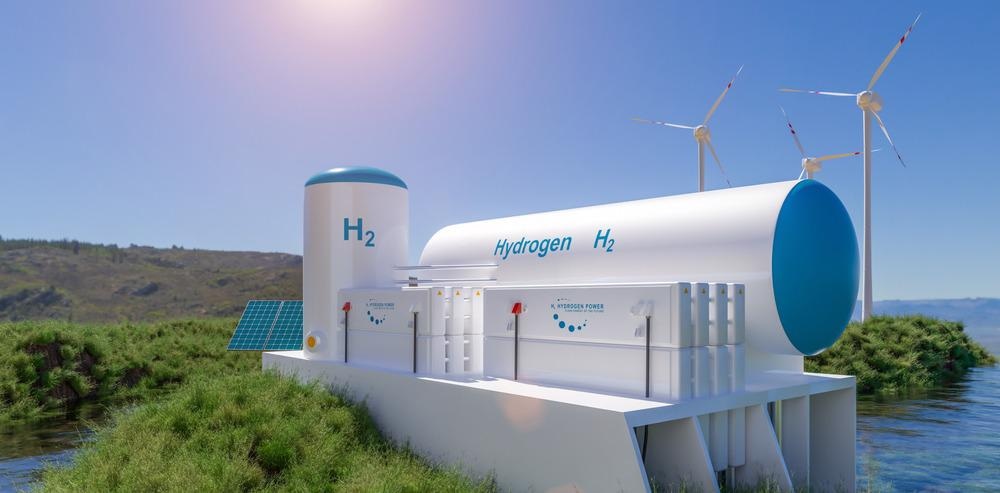The government of Oman has announced plans to begin construction on what will be the largest green hydrogen plant in the world. Leveraging energy industry experience and the perfect conditions for creating hydrogen with renewable energy, Oman is taking proactive steps to diversify its economy away from heavy reliance on oil and gas.

Image Credit: Alexander Kirch/Shutterstock.com
Building the World’s Largest Green Hydrogen Plant
The Arabian Peninsula sultanate intends to start building the plant in the Al Wusta governorate on the Arabian Sea in 2028. The project will develop in stages and full capacity is expected to be reached by 2038.
At this point, 25 gigawatts of wind and solar energy will be used to produce more green hydrogen than any other facility in the world.
The plant is expected to cost €30 bn, and funding has come from Oman’s state energy company, QC, Chinese renewable hydrogen developer, InterContinental Energy, and a Kuwait-based energy investor, Enertech.
Green Hydrogen Production
The Oman green hydrogen plant will use renewable energy to split water in an electrolyzer, producing hydrogen. The plant’s total reliance on renewable energy will result in actual environmental benefits and a reliably green hydrogen fuel product.
While hydrogen fuel is a much cleaner fuel to use in terms of emissions, the significantly large energy costs to split water and produce it typically outweigh the emissions benefit. Hydrogen is only green if plants rely entirely or mostly on renewable energy, ideally collected and stored on-site or nearby.
All hydrogen fuels are cleaner than fossil fuels in terms of emissions and pollution. Hydrogen does not burn off carbon when it is used and does not increase CO2 levels in the atmosphere.
Hydrogen provides enough combustion energy to effectively replace fossil fuels for demanding applications such as transportation and electricity generation. The Oman green hydrogen plant will be able to distribute hydrogen as it is or converted it into green ammonia which is easier to store and transport.
Most of its production is intended for export markets to Europe and Asia. When complete, the facility is expected to produce 1.8 million tons of hydrogen and 10 million tons of green ammonia every year.
Preparing for the Future of Energy
Currently, 85% of Oman’s GDP comes from its oil and gas industries. However, with reserves of these fossil fuels dwindling, the country is working towards more economic and industrial diversification.
Constructing the world’s largest green hydrogen plant is a move away from Oman’s economic reliance on oil and gas, and is a step toward protecting the country from economic collapse in the next few decades.
As well as diversifying its economy while leveraging its energy sector experience, Oman is also capitalizing on ideal environmental conditions for green hydrogen production.
The country receives a large amount of daytime sunlight throughout the year. It also experiences very high winds when the sun goes down at night. This means that renewable energy is relatively cheap, easy to obtain, and can be generated close to the green hydrogen plant.
Why is Green Hydrogen Production Important?
The most effective way to decarbonize most economic sectors and areas of human activity is with electrification. This way, energy demand can be easier met by renewable sources, and consumption can be optimized and minimized.
However, there is a significant portion of the economy for which the relatively low energy output of electricity is insignificant for business purposes. Heavy industries such as steel, chemicals, aviation, and shipping need an energy source that is capable of the high amounts of combustive energy produced by fossil fuels.
Hydrogen can meet this demand, but if it is not produced with renewable energy technology then it still leads to unacceptable amounts of carbon emissions in its manufacture.
Governments worldwide have recognized the benefits of hydrogen fuel, with many planning or funding their own hydrogen development projects. However, currently, only 1% of the hydrogen produced worldwide is made with renewable energy.
The remaining 99% leads to 830 million tons of carbon being emitted every year. While some of this is captured and sequestered – in blue hydrogen production – economic and environmental costs remain high.
Truly green hydrogen can, however, effectively replace fossil fuels without leading to more environmental damage. Developments on the world’s largest green hydrogen plant will be closely watched, and many will be anticipating the plant’s first delivery of truly green hydrogen.
What Is Green Hydrogen And Will It Power The Future?
Video Credit: CNBC/YouTube.com
References and Further Reading
Abouzzohour, Yasmina (2021). “One Year Into His Reign, Oman’s Sultan Must Renegotiate the Social Contract and Prioritize Diversification.” Brookings.edu. [Online] https://www.brookings.edu/blog/order-from-chaos/2021/01/13/one-year-into-his-reign-omans-sultan-must-renegotiate-the-social-contract-and-prioritize-diversification/.
IEA (2021). “Net Zero by 2050.” IEA. [Online] https://www.iea.org/reports/net-zero-by-2050.
Paddison, Laura (2021). “Oman Plans to Build World’s Largest Green Hydrogen Plant.” Guardian. [Online] https://www.theguardian.com/world/2021/may/27/oman-plans-to-build-worlds-largest-green-hydrogen-plant.
Disclaimer: The views expressed here are those of the author expressed in their private capacity and do not necessarily represent the views of AZoM.com Limited T/A AZoNetwork the owner and operator of this website. This disclaimer forms part of the Terms and conditions of use of this website.